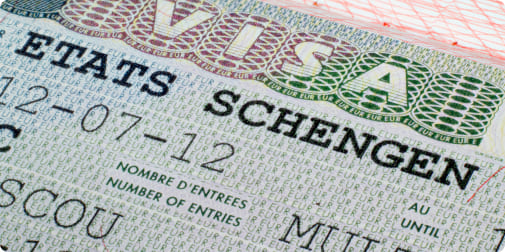Schengen Visa Types and Their Requirements
You will need a Schengen visa if your country is not one of the ETIAS visa waiver countries. Find out more about traveling to Europe with a Schengen Visa.

Get notified when ETIAS is mandatory

Start ETIAS Application online

Receive ETIAS confirmation

Welcome to Europe

What is Schengen Visa?
The Schengen Zone is made up of 26 countries. Two-thirds of these countries are members of the European Union, and the remaining four are members of the EFTA (European Free Trade Association). It was created by a mutual agreement that allows the free movement of all Schengen citizens, eliminates internal borders and strengthens external borders. You need Schengen visa to visit any of the member states if you are not a visa-exempt citizen.
Three microstates and the 26 members of the Schengen Zone are also part of the area.
The following microstates are also eligible for entry under the Schengen visa:
• The Vatican
• Monaco
• San Marino
Romania, Bulgaria, and Croatia are all members of the European Union, but not the Schengen Agreement. Below you will find information about the short-term visas available for each country.
Non-European citizens who do not require a short-term visa to enter Schengen member countries will need to apply for an ETIAS travel permit. These countries will require an ETIAS valid upon arrival.
Schengen zone countries (ETIAS countries)
 Austria
Austria Belgium
Belgium Czech Republic
Czech Republic Denmark
Denmark Estonia
Estonia Finland
Finland France
France Germany
Germany Greece
Greece Hungary
Hungary Iceland
Iceland Italy
Italy Latvia
Latvia Liechtenstein
Liechtenstein Lithuania
Lithuania Luxembourg
Luxembourg Malta
Malta Netherlands
Netherlands Norway
Norway Poland
Poland Portugal
Portugal Slovakia
Slovakia Slovenia
Slovenia Sweden
Sweden Spain
Spain Switzerland
Switzerland
 Bulgaria
Bulgaria Croatia
Croatia Cyprus
Cyprus Ireland
Ireland Romania
Romania Monaco
Monaco San Marino
San Marino Vatican
Vatican
Non-Schengen European Union members
Republic of Ireland
The Republic of Ireland is not yet part of the Schengen Area. There are a lot of countries that allow citizens to enter Ireland without requiring a visa. These are:
• United States
• Canada
• Argentina
• Brazil
• Taiwan
• South Korea
• Japan and many other countries
While citizens from the above countries do not require a visa to travel into Ireland at the moment, this will probably change shortly, and they will need an ETIAS visa waiver to cross the border into Ireland.
Bulgaria
The Bulgarian government ruled that all Schengen visa holders could enter and leave Bulgaria without restriction on January 25, 2012. Applicants must meet some requirements.
• All eligible nationals must carry a valid Schengen visa
• The Schengen visa does not allow for more than two entries per day.
• The same visa is not valid for those who have exceeded the Schengen Area’s entry and/or day limit.
• The holder of a valid short-term visa for Ireland, Cyprus, Romania, or Croatia cannot enter Bulgaria.
All citizens of the 60 countries who do not currently require a visa to visit Bulgaria will need to submit an ETIAS online after the ETIAS travel authorization system is implemented.
Romania
Like the other countries on the list, Romania is not yet a member of the Schengen Area. Romania is, however, a member of the European Union. Romanian authorities have granted foreign nationals with Schengen visas to enter Romania for short-term stays, provided they meet all requirements. For a maximum of 90 days and every 180 days (six months), US citizens are not required to obtain a visa to enter Romania. However, once the ETIAS application has been implemented and is operational, this will change. Citizens from other countries, including the USA, who wish to enter Romania without a visa will apply for an ETIAS.
Croatia
Croatia is one of few countries that doesn’t require visas from the US or Canada. It does not require visas for Australia, New Zealand, Australia, and EU nationals. There are currently more than 50 countries that can enter or exit Croatia with no visa. However, because Croatia is a member of the ETIAS agreement, this will soon change. Citizens from visa-exempt countries will have to apply for an ETIAS travel permit.
Cyprus
Cyprus is similar to other European countries not on the non-Schengen European List. All visitors will soon be required to obtain an ETIAS travel authorization. Citizens from more than 50 countries do not need to apply for visas before traveling to Schengen member countries.
Andorra
In the beginning, Andorra had been announced as an ETIAS-eligible country. This would have meant that Andorran passport holders would have to have a valid travel authorization to cross into the Schengen Area. Officially, the Andorran government has confirmed that they will not require their nationals to have an ETIAS travel permit to cross the Schengen border.
United Kingdom: Is Schengen visa valid for the UK?
Most nationals of visa-exempt Schengen Area nations could enter the United Kingdom before Brexit if they wanted to travel for a short-term visit.
The ETIAS visa waiver is no longer valid for travel to the UK, as the United Kingdom has withdrawn from the European Union. ETIAS will travel to Schengen countries from the United Kingdom by the European Union.
Third-country travelers should show proof of sufficient financial resources or a current document proving their residence at passport control. Below is a list showing the documents that border control officers can use to determine whether a traveler can cross the British frontier.
An official letter from an employer or a bank statement will be required to prove that the applicant is able to pay for their expenses while in the UK.
A bill or residential card proving legal residency displaying the name and address of the traveler is acceptable proof.
Documentation proving employment or continuing studies
A copy of the parent’s passport may be required for travelers under 18 years old. It may be necessary to provide a copy of the passport of the parents.

Get notified when ETIAS becomes mandatory
Schengen Visa Types
Any Schengen member state can issue a Schengen visa that allows its holders to travel freely across the borders of any Schengen country. The Schengen visa grants entry to all European Free Trade Association (EFTA), Schengen countries. The Schengen Area member countries of the European Union grant visa-free entry to third-country nationals as long as they meet two requirements:
1. they must hold a valid Schengen Via
2. their country has signed a visa waiver agreement to visit the non-Schengen European country.
1. UNIFORM SCHENGEN VISA
A Uniform Schengen visa, issued by one member country of the Schengen Area, allows residence in the desired Schengen nation for up to 90 days. This is valid for 180 days after the initial entry date. You can also use the USV as a transit visa.
There are three subcategories to the Uniform Schengen Visa
The Uniform Schengen Visa permits a single entry into a Schengen country for a short period. The visa expires when the foreign visitor leaves the country.
Double-entry visa holders can only enter Schengen member states twice. The visa expires immediately after the second exit (second crossing an external Schengen border.
A multiple-entry visa allows holders to enter and leave the Schengen member countries at any time during the visa’s validity. Their stay must not exceed 90 days per 6 months starting at the date of entry.
2. Limited Territorial Validity Visa
A Limited Territorial Validity Visa Holder cannot travel to or transit to any country other than the one where the visa was issued. The LTV holder may only enter the Schengen country where the visa was issued. They cannot enter any other Schengen country unless authorized to do so during the visa application process.
3. NATIONAL VISA
National Visas can be granted to those studying, working, or permanently residing within any Schengen Area country. This visa would be sufficient to cover the specific purpose of the visa request (e.g., education or employment). Normal circumstances dictate that the National Visa is a one-entry visa valid for a short period.
There are some circumstances where travelers can apply for a multi-entry National Visa. Applicants must meet the following requirements:
• You must apply for enrollment in an international education program with a maximum duration of one year. You must prove this through an official document.
• You can apply for pedagogical positions at higher education or educational centers.
• A professional who travels to Europe because of his/her expertise in sports, arts, or any other profession that involves sharing expertise
• If an emergency occurs, the applicant cannot return to their country. They must stay in the Schengen Area for a specified period.
If an applicant cannot satisfy the Schengen visa requirements, the visa will be rejected. It could mean that applicant either could not prove the purpose of the travel, could not provide sufficient travel insurance, couldn’t confirm that they had a place to live, etc. Other reasons may include the criminal record with significant offenses, unacceptable travel history (deports), or invalid documents.
Schengen Tourist Visa Requirements
Here are the requirements for a Schengen Visa. It is best to contact the local consulate or embassy for more information about each application and where the Schengen visa interview will be held.
- Complete ETIAS Application Form (once ETIAS requirements are mandatory)
- A passport-style photo of you shows your face in a clear, front view and a white background.
- Passenger's passport and photocopies of any previous Schengen visas. The passport should have at least two blank pages and be valid for three months before departure.
- You must prove that you have sufficient funds to pay for your trip.
- 5. Round trip reservations, such as hotel/room/flight reservations, must include their identifying reservation numbers. The travel information must clearly show the date of entry and departure from the Schengen Area.
- 6. Insurance covers travel health, which includes all periods within Schengen member countries.

FAQs on Schengen Visa Types and Requirements
Can’t find what you are looking for?
Reach out to our customer support team.
There are three major types of Schengen visas: Uniform Schengen Visa (USV), Limited Territorial Validity Visa (LTV), and National Visa. USV means that the holder of the visa can travel freely among the different Schengen Area countries. However, USV itself comes in three different types: single-entry, double-entry and multiple-entry visas. LTV visa restricts the holder from freely visiting other Schengen countries except for the one that it was granted a visa. National Visa is a visa for a specific member state of the Schengen Area but often allows for travel within the Schengen Area without any restrictions.
Citizens of any non-European country are eligible for a Schengen visa given that they wish to remain in the Schengen zone for more than 90 days. According to the eligibility criteria, the applicant should own a valid passport for at least 3 months after the application date. Also, the visa holder will be required to have medical insurance of at least 30,000 Euros. The rest of the eligibility criteria will vary from country to country, as well as the type of the Schengen visa needed.